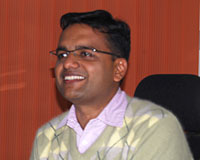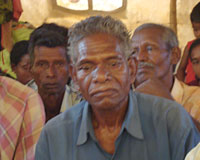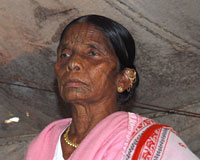Refugee camps in India’s nuclear age
by - 19th January 2009
We travelled through a seeming paradise all day yesterday to get to the edge of hell. All day the calm beauty of the Orissa countryside seduced us. White long-horned cattle against deep red sandstone-mud cottages; thatched hay-ricks on stilts, the harvest safely gathered in. An old man in a fine white handspun dhoti walking calmly behind his single cow, umbrella aloft against the still fierce winter sun. A small boy with a string of shells and tiny bells around his loins. Women in dazzling saris washing clothes in ponds full of lotus flowers. And behind it all, etched against the sky through the coconut palms, the Khond hills rising shadowy with menace.
For it is in the hills that the horror is still happening. Huge tree trunks that had been felled to block the roads in advance of the summer slaughter of Christians now marked the verges at regular intervals where government militia had eventually hauled them out of the way. As we climbed up out of the green and pleasant plains into the ‘jungle’ at the heart of India, the sense of something awful having happened made itself felt like a premonition. Very few people; here and there a smashed church; an unkemptness in the thatch in marked contrast to the orderliness of the villages we’d just been through.
Where was everyone?
That’s the tragedy. The people are gone, and so many won’t be coming back. For these were majority Christian villages. They belonged to the Pana Scheduled Caste – dalits, the lowliest of all in India’s medieval pecking order. Thousands are in miserable camps, or crammed into mission compounds in neighbouring towns. They can’t go back unless they ‘re-convert’ to a distorted brand of Hinduism that is still on the rampage, despite government security measures.
 The Khandamal Collector Dr Krishna Kumar who was posted just as the violence broke out, following rumours of impending trouble in July, is sanguine about the success of the reconciliation process.
The Khandamal Collector Dr Krishna Kumar who was posted just as the violence broke out, following rumours of impending trouble in July, is sanguine about the success of the reconciliation process.
He was himself physically attacked on a fact-finding tour of the district, after the initial riots. He has invoked the National Security Act four times and believes the government is now providing all the support he needs.
He admits: ‘My heart bleeds for these people. This is a century-long tribal conflict, complicated by land issues. But we are progressing quite fine and well.’
He meets with faith community leaders every Saturday morning – but laments the lack of statesmen with sufficient calibre to initiate a truth and reconciliation commission.
It would be too late for many anyway.
Of the 50,000 who fled into the jungle after the killers struck on 25 August, 15,000 have still not gone home to their villages. 8,000 of those are dispersed to seven of the original 17 camps throughout Khandamal. Twelve hundred families are starting a grim new life in slums a world away in Orissa’s capital, Bhubaneswar. Others have left for church compounds as far away as Delhi.
Catholic social worker, 32-year old Fr Manoj Kumar Nayak, cannot return to his own village for fear of forced reconversion or death. His own father, the catechist and postmaster in Tiangiya village, underwent forced conversion – with an axe at his neck.
‘He was the most respected person in that area. We never had any enmity against them. If people – Hindus - went hunting from the village, every time they gave something to my father, he was so respected.
‘Local people were used by outsiders, petty traders, to commit atrocities. Bodies were lying everywhere.
‘There was no other choice for my father. Those who remained in the village were converted. All the churches, Roman Catholic, Baptist, Pentecostal, were broken and no prayer is conducted. They looted everything. They burned our houses, even the doors and windows were taken. Even the foundations cannot be seen any longer. It was total eradication.
‘People are being given ten kilos of rice and forcefully sent back to their village but there is no protection. To save face, police are sending them home, beating them.’
A large group gathers in a steaming tent as we make our way through G. Udayagiri camp. We sit and listen as one by one the people speak up: the retired government medical college lab technician who’d had 25 lakhs of rupees worth of property destroyed – around £35,000.
 The desperately sad-looking man who’d been dragged to a temple and forced to don the sacred thread of Hinduism or face the destruction of his home. Then being threatened again unless he ‘proved’ his conversion by destroying another Christian’s home – and fleeing instead to this desolate tent town.
The desperately sad-looking man who’d been dragged to a temple and forced to don the sacred thread of Hinduism or face the destruction of his home. Then being threatened again unless he ‘proved’ his conversion by destroying another Christian’s home – and fleeing instead to this desolate tent town.
The young mother, tiny naked baby in her arms, weeping as she tells how, though heavily pregnant, she had faced a mob of 300 masked men, alone.
When they came to her village, she had sent her husband away in the belief they would be kinder to her because of her condition. Tears stream down the faces of all the women sitting behind her as she tells how she was forced to burn her Bible.
Amazingly, she found the courage to refuse to do it. She said she didn’t have a matchbox. So they gave her one. Then they forced her to get kerosene - and finally the Bible burned.Later she fled to the camp, and one day later her tiny boy was born – safely.
These are by no means the worst stories we’ve heard over a week of travelling in the Khandamal district. We’ve heard of prolonged torture, rape, children being thrown onto fires, a madness without mercy that went on not just for one terrible day, but for weeks, and is still going on.
But what marks out these stories is the grief of people for whom betrayal of their faith is almost as painful as loss of loved ones.
An old woman rises to her feet, and stands there until there is silence enough for her to tell her remarkable story.
 Her name is Sumabati Pradhan from Dokodi village, in Rotingia Panchayat. She is 65 years old and immensely dignified.
Her name is Sumabati Pradhan from Dokodi village, in Rotingia Panchayat. She is 65 years old and immensely dignified.
Her fine face is lined with tribal tattoos and she twitches a pink shawl round her frail shoulders. Her voice wavers, but does not break until the very end.
Twelve years ago, she tells us, she was a Hindu leader, President of the local Samaj or party, serving Swami Laksmanananda Saraswati, the man whose death at the hands of Maoists was the excuse for the attacks on Christians on 23 August.
He had been poisoning the wellsprings of co-existence for years, according to many we spoke to.
It was Sumabati’s job to wash the Swami’s feet, and as is the custom for Brahmin wives and priestly acolytes, to drink the water they’d been washed in.
She used to overhear the Swami saying there should be no Christianity; that all Christians should be killed.
She had spoken up. She had protested that she had spent her life worshipping the goddess Durga and performing the rituals and there had never been any talk of killing before.
Then, when her husband and daughter died within a short time of each other, she met a mendicant preacher, Saddhu Kisand Singh, who prayed with her, and she found new life, peace and healing.
The RSS mob that attacked her village threatened her unless she re-convert.
Then the tears begin to flow. Just eight days before our visit, on 8 January, her daughter had been persuaded by the military police that it was safe enough to return to the village to collect the rice ration – a government confidence-building measure, half-way to full rehabilitation.
But so-called Durga fighters – a lathi-wielding female branch of the RSS - had ambushed her and threatened to cut her into pieces if she refused to convert.
Through Fr Manoj’s translation, Sumabati cries out: ‘How can we go back to our villages?’
This feisty grandmother even went to the police station near the camp at G. Udayagiri to lodge a First Incident Report with R500 she had salvaged, and told them to use it to buy petrol to arrest the Durga women.
But as has been so often the case, there has been no follow-up.
These ill-treated people are being ethnically cleansed by a barbaric branch of the BJP – the Hindu nationalist party - that could one day control India’s civilian nuclear capacity.
Ironic that it is a capacity – fuel and technology for six new reactors - bestowed on them by the most Christian country on earth: America.
- Log in to post comments
